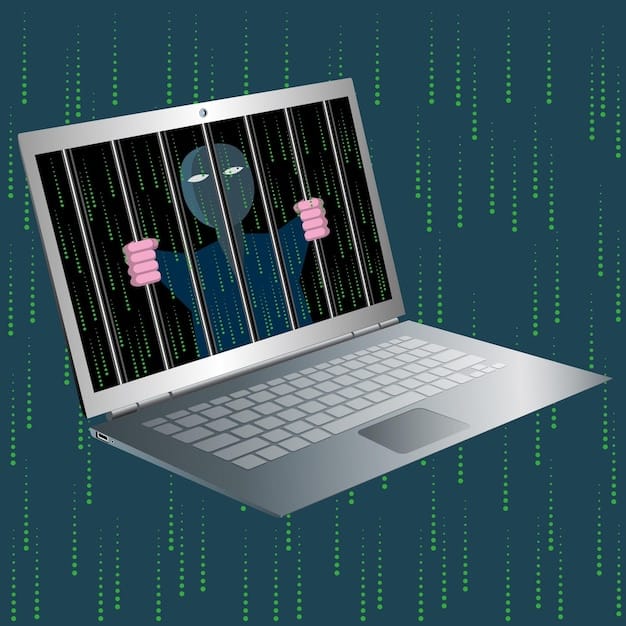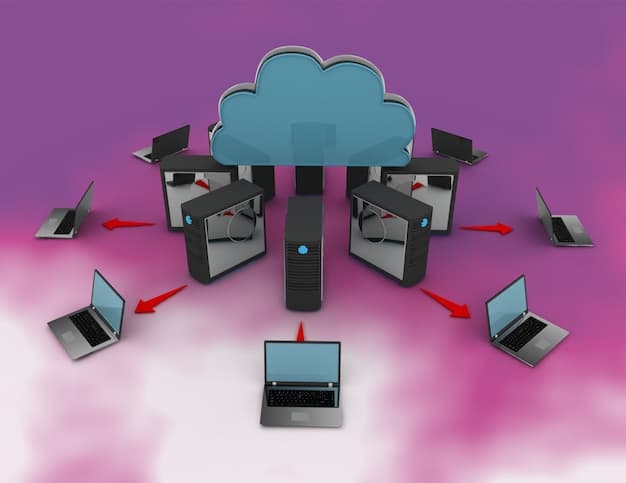Ransomware Attacks Up 15% in US: Protect Your Business Now

Ransomware attacks in the US have surged by 15%, underscoring the urgent need for businesses to implement robust cybersecurity measures, including employee training, advanced threat detection, and comprehensive data backup and recovery plans, to mitigate potential financial and reputational damage.
The threat of ransomware attacks in the US has increased by 15%, presenting a significant challenge for businesses of all sizes. Are you prepared to defend your valuable data and systems against these increasingly sophisticated cyber threats? Let’s explore the current landscape and actionable strategies to safeguard your business.
Understanding the Ransomware Threat Landscape in the US
To effectively combat the rising tide of ransomware, it’s crucial to first understand the current threat landscape in the United States. This involves recognizing the types of attacks, the common targets, and the evolving tactics used by cybercriminals.
Common Types of Ransomware Attacks
Understanding the various types of ransomware attacks is essential for developing a targeted defense strategy. Each type employs different methods to infiltrate and encrypt data, requiring tailored countermeasures.
- Locky: Often spread through malicious email attachments, Locky encrypts files with a .locky extension, demanding a ransom for decryption.
- Ryuk: Known for targeting large organizations, Ryuk is often deployed after an initial network compromise, focusing on high-value data.
- WannaCry: This worm-like ransomware spreads rapidly through networks, exploiting vulnerabilities in older Windows systems.
- Cerber: Cerber is distributed via email and exploit kits, and it is notable for its Ransomware-as-a-Service (RaaS) model, making it accessible to less skilled cybercriminals.

Who Are the Primary Targets?
While no business is entirely immune, certain sectors and organizational sizes are more frequently targeted by ransomware attacks. Understanding these trends can help businesses assess their risk level and allocate resources accordingly.
- Healthcare: Hospitals and healthcare providers are prime targets due to the sensitive nature of patient data and the urgent need for access to medical records.
- Education: Schools and universities are often targeted due to limited cybersecurity budgets and a large number of users accessing the network.
- Small and Medium-sized Businesses (SMBs): SMBs are often seen as easier targets due to limited IT resources and less sophisticated security measures.
- Government Agencies: Government entities at the local, state, and federal levels are increasingly targeted for sensitive information and disruption of public services.
Understanding the ransomware threat landscape, from common attack types to primary targets, is the first step in building a robust defense. By recognizing these trends and vulnerabilities, businesses can better assess their risk and implement appropriate security measures.
Assessing Your Business’s Vulnerabilities
Before implementing any cybersecurity solutions, it’s critical to assess your business’s current vulnerabilities. This involves identifying potential weaknesses in your systems, network, and employee practices that could be exploited by ransomware attackers.
Conducting a Comprehensive Risk Assessment
A thorough risk assessment can help identify areas where your business is most vulnerable to ransomware attacks. This involves evaluating your IT infrastructure, data storage practices, and employee security awareness.
Evaluating Your Current Cybersecurity Measures
Take a close look at your existing security tools and protocols. Are your firewalls, antivirus software, and intrusion detection systems up to date? Do you have a robust backup and recovery plan in place? Regular evaluations are essential to ensure your defenses are strong.
Assessing your business’s vulnerabilities involves conducting a comprehensive risk assessment, evaluating current cybersecurity measures, and identifying potential weaknesses. This proactive approach is essential for developing a targeted and effective defense against ransomware attacks.
Implementing Robust Security Measures
Once you’ve assessed your vulnerabilities, it’s time to implement robust security measures to protect your business from ransomware attacks. This involves a multi-layered approach that includes technology, policies, and employee training.
Firewall and Intrusion Detection Systems
A strong firewall is your first line of defense against unauthorized access to your network. Intrusion detection systems (IDS) can help identify and block malicious activity in real-time. Regularly update these systems to protect against the latest threats.
Antivirus and Anti-Malware Software
Ensure all computers and servers are equipped with up-to-date antivirus and anti-malware software. These tools can detect and remove ransomware before it can encrypt your data. Consider using endpoint detection and response (EDR) solutions for advanced threat detection.
Employee Training and Awareness
Your employees are often the weakest link in your cybersecurity defenses. Provide regular training to help them recognize phishing emails, avoid suspicious links, and follow security best practices. Simulating phishing attacks can help reinforce this training.

Regular Data Backups
Regularly back up your data to an offsite location or cloud storage. Ensure that backups are tested regularly and that you have a clear recovery plan in case of a ransomware attack. Consider using the 3-2-1 backup rule: three copies of your data, on two different media, with one copy offsite.
- Implement multi-factor authentication (MFA) for all critical systems and accounts.
- Patch software vulnerabilities promptly, as these are often exploited by ransomware attackers.
- Segment your network to limit the spread of ransomware in case of an infection.
Implementing robust security measures is crucial for protecting your business from ransomware attacks. By investing in firewalls, antivirus software, employee training, and data backups, you can significantly reduce your risk.
Creating a Data Backup and Recovery Plan
A comprehensive data backup and recovery plan is essential for minimizing the impact of a ransomware attack. This involves regularly backing up your data, testing your backups, and having a clear plan for restoring your systems.
Regularly Backing Up Your Data
Establish a schedule for backing up your data on a regular basis. Consider using automated backup solutions to ensure that backups are performed consistently. Store backups in a secure location that is separate from your primary systems.
Testing Your Backups
Don’t wait until a ransomware attack to find out that your backups are corrupt or incomplete. Regularly test your backups to ensure that you can restore your data quickly and effectively. Conduct mock recovery drills to identify any weaknesses in your plan.
Developing a Recovery Plan
Create a detailed recovery plan that outlines the steps you will take to restore your systems in the event of a ransomware attack. This plan should include clear roles and responsibilities, as well as procedures for identifying the source of the attack and preventing it from spreading.
Creating a data backup and recovery plan is a critical step in protecting your business from ransomware. By regularly backing up your data and having a clear plan for restoring your systems, you can minimize downtime and data loss in the event of an attack.
Responding to a Ransomware Attack
Despite your best efforts, a ransomware attack may still occur. Knowing how to respond quickly and effectively can minimize the damage and help you recover your systems. This involves isolating the infected systems, assessing the scope of the attack, and notifying the appropriate authorities.
Isolating Infected Systems
The first step in responding to a ransomware attack is to isolate the infected systems from the rest of your network. This can prevent the ransomware from spreading to other devices and encrypting more data. Disconnect the infected systems from the internet and any shared drives.
Assessing the Scope of the Attack
Determine which systems have been affected and what data has been encrypted. This will help you assess the extent of the damage and prioritize your recovery efforts. Use forensic tools to identify the source of the attack and any other vulnerabilities that may have been exploited.
Notifying the Authorities
Report the ransomware attack to the appropriate authorities, such as the FBI or the Department of Homeland Security. They can provide assistance with the investigation and help you understand your legal obligations. Also, consider notifying your insurance provider and any affected customers or partners.
- Do not pay the ransom unless you have no other options. Paying the ransom does not guarantee that you will get your data back, and it may encourage further attacks.
- Consult with cybersecurity experts to help you recover your systems and data. They can provide guidance on the best course of action and help you implement additional security measures to prevent future attacks.
Responding to a ransomware attack requires quick and decisive action. By isolating infected systems, assessing the scope of the attack, and notifying the authorities, you can minimize the damage and begin the recovery process.
Staying Updated on the Latest Threats and Trends
The ransomware landscape is constantly evolving, with new threats and tactics emerging all the time. Staying updated on the latest trends and best practices is essential for maintaining a strong cybersecurity posture. This involves monitoring industry news, attending cybersecurity conferences, and working with trusted security vendors.
Monitoring Industry News and Blogs
Stay informed about the latest ransomware threats by monitoring industry news sources, security blogs, and threat intelligence reports. This will help you understand the tactics being used by attackers and the vulnerabilities they are exploiting.
Attending Cybersecurity Conferences and Webinars
Attend cybersecurity conferences and webinars to learn from experts and network with other professionals in the field. These events can provide valuable insights into the latest threats and best practices, as well as opportunities to connect with vendors and partners.
Working with Trusted Security Vendors
Partner with trusted security vendors who can provide you with the latest threat intelligence, security tools, and expert guidance. They can help you assess your vulnerabilities, implement security measures, and respond to incidents.
Staying updated on the latest threats and trends is crucial for protecting your business from ransomware. By monitoring industry news, attending cybersecurity events, and working with trusted security vendors, you can stay ahead of the curve and maintain a strong cybersecurity posture.
| Key Point | Brief Description |
|---|---|
| 🛡️ Risk Assessment | Identify vulnerabilities in your systems and network. |
| 🔒 Security Measures | Implement firewalls, antivirus, and employee training. |
| 💾 Data Backup | Regularly back up data and test recovery processes. |
| 🚨 Incident Response | Quickly isolate infected systems and notify authorities. |
FAQ
▼
Ransomware is a type of malware that encrypts a victim’s files, making them inaccessible, with the attacker then demanding a ransom to restore access to the data. It often spreads through phishing emails or by exploiting software vulnerabilities.
▼
Immediately isolate the infected systems to prevent further spread. Assess the scope of the attack to understand the extent of the damage. Notify the appropriate authorities and consult with cybersecurity experts on recovery options.
▼
Provide regular training sessions that cover how to identify phishing emails, avoid suspicious links, and follow security best practices. Conduct simulated phishing attacks to reinforce the training and assess employee vigilance.
▼
Paying the ransom is generally discouraged as it doesn’t guarantee data recovery and may encourage future attacks. Consider it only as a last resort, after exhausting all other recovery options, and consult cybersecurity experts first.
▼
A robust plan should include regular automated backups, offsite storage, and tested recovery procedures. It’s also advisable to follow the 3-2-1 rule: three copies of your data, on two different media, with one copy offsite.
Conclusion
In conclusion, with ransomware attacks in the US up 15%, protecting your business data requires a proactive and multi-faceted approach. By understanding the threat landscape, assessing vulnerabilities, implementing robust security measures, and having a solid recovery plan, businesses can significantly reduce their risk and ensure business continuity.





